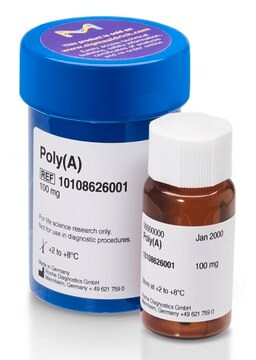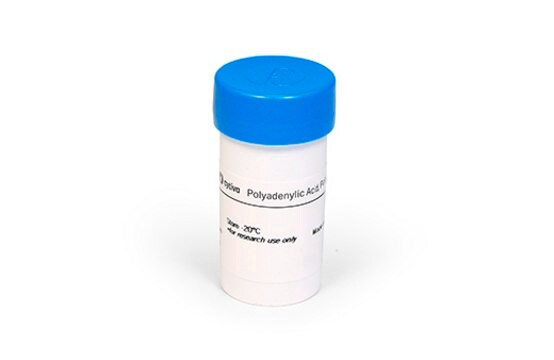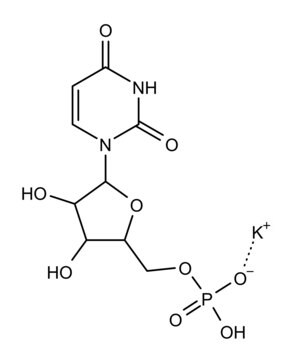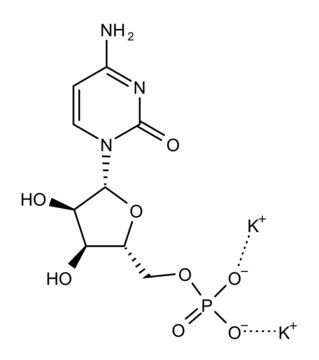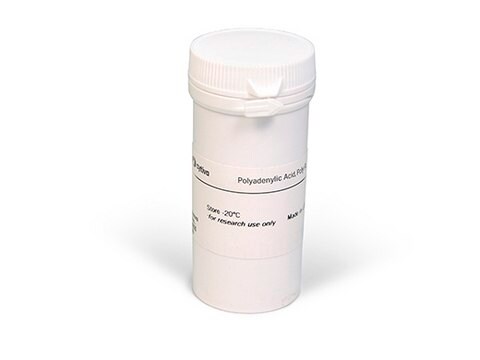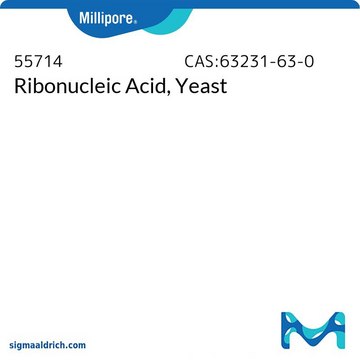P9403
poly(A)
Synonyme(s) :
Polyadenylic acid potassium salt, Poly(A) potassium salt
Se connecterpour consulter vos tarifs contractuels et ceux de votre entreprise/organisme
About This Item
Produits recommandés
Vous recherchez des produits similaires ? Visite Guide de comparaison des produits
Application
Polyadenylic acid (poly-A) is used to evaluate binding on cationic liposomes doped with non-ionic nucleolipids. Poly-A is used in small molecule mRNA targeted drug development to evaluate the binding of potential therapeutic agents such as the Isoquinoline group of alkaloids.
Notes préparatoires
Prepared from ADP with polynucleotide phosphorylase
Code de la classe de stockage
11 - Combustible Solids
Classe de danger pour l'eau (WGK)
WGK 3
Point d'éclair (°F)
Not applicable
Point d'éclair (°C)
Not applicable
Équipement de protection individuelle
Eyeshields, Gloves, type N95 (US)
Faites votre choix parmi les versions les plus récentes :
Déjà en possession de ce produit ?
Retrouvez la documentation relative aux produits que vous avez récemment achetés dans la Bibliothèque de documents.
Prabal Giri et al.
Molecular bioSystems, 6(1), 81-88 (2009-12-22)
The use of small molecules to specifically control important cellular functions through binding to nucleic acids is an area of major current interest at the interface of chemical biology and medicinal chemistry. The polyadenylic acid [poly(A)] tail of mRNA has
Tian-Li Duan et al.
Cells, 8(8) (2019-08-08)
Poly(A)-specific ribonuclease (PARN), a multifunctional multi-domain deadenylase, is crucial to the regulation of mRNA turnover and the maturation of various non-coding RNAs. Despite extensive studies of the well-folding domains responsible for PARN catalysis, the structure and function of the C-terminal
Prabal Giri et al.
Mini reviews in medicinal chemistry, 10(7), 568-577 (2010-05-27)
After fifty years of DNA targeting through intercalators and groove binders and related studies now the current focus is in RNA targeting. Polyadenylic acid [poly(A)] tail of mRNA has been recently established as a potential drug target due to its
Natallia Makarava et al.
Acta neuropathologica communications, 6(1), 92-92 (2018-09-14)
Last decade witnessed an enormous progress in generating authentic infectious prions or PrPSc in vitro using recombinant prion protein (rPrP). Previous work established that rPrP that lacks posttranslational modification is able to support replication of highly infectious PrPSc with assistance
Polyadenylic acid binding on cationic liposomes doped with the non-ionic nucleolipid Lauroyl Uridine.
Cuomo F, Ceglie A, Colafemmina G, et al.
Colloids and Surfaces, B: Biointerfaces, 82, 277-282 (2011)
Notre équipe de scientifiques dispose d'une expérience dans tous les secteurs de la recherche, notamment en sciences de la vie, science des matériaux, synthèse chimique, chromatographie, analyse et dans de nombreux autres domaines..
Contacter notre Service technique